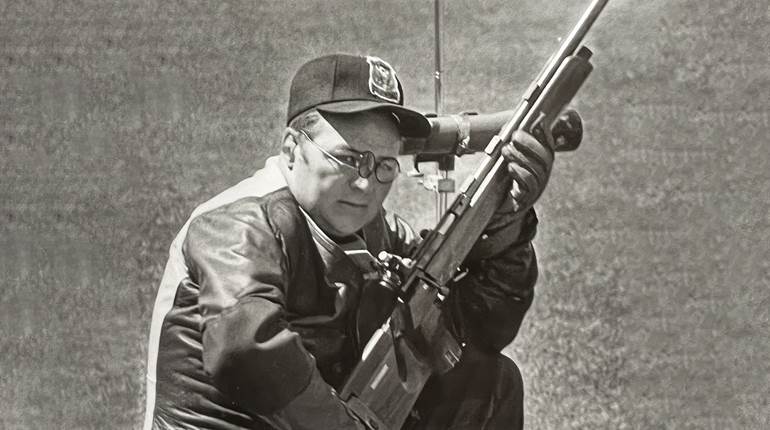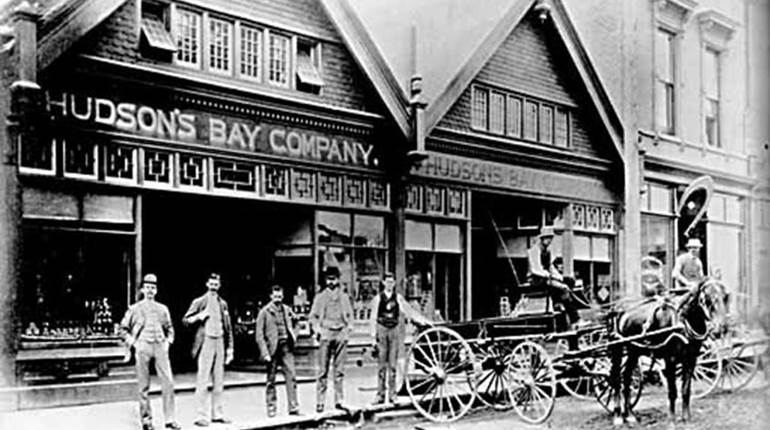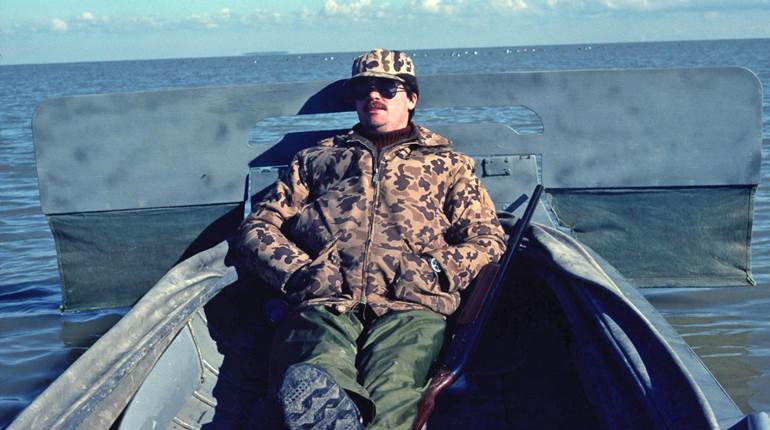
This article was first published in The American Rifleman, December 1969 as part of a special report titled, "Can U.S. Troops Still Shoot?" reflecting on the state of U.S. marksmanship in the major wars of that century.
By Brig. Gen. S.L.A. Marshall, USA (Ret)
About the Author: One of the Natin's outstanding military writers, Brig. Gen. S.L.A. Marshall, USA (Ret.) learned his subject in two World Wars and several smaller ones. A newspaperman, he rose from first lieutenant in World War I to brigadier general during service in 1942-52. He is the author of more than 20 books on military history and related topics.
Vietnam is uniquely a rifleman’s war. In casualty-producing impact, rifle fire is the predominating force. This is true on both sides. In excess of 70% of the casualties inflicted and received on both sides are caused by rifle bullets, according to my best information and approximation.
The mix of M16 and M60 fire by our fighting line is the main enemy stopper. As the two are applied together quite consistently, it is impossible to say positively how the toll taken by the heavier M60 in 7.62 mm compares with that of individual riflemen using the 5.56 mm M16. But after analyzing several score engagements, my impression is that the M16 bests the M60 by better than two to one. Again, as an approximation, their combined fires must account for 75% of the battle losses on the enemy side.
As for our own casualties, more than 70% of Americans killed or wounded are taken out by the bullet, and somewhat more than 60% of the hits are in the head or the upper part of the body. The AK-47 rifle, the SKS carbine, and sometimes the M16 or M14 in enemy hands, are their capital weapons. Enemy machine guns are rarely a major affliction. 
The nature of the average engagement accounts for this absolute contrast in weapons effects between Vietnam and earlier wars of the century. The range between sides giving battle over there most of the time is somewhere between 10 and 30 meters and is almost never more than 100 meters. Even that maximum would have been minimal in Korean and World War I and II operations.
Less than 20% of South Vietnam’s surface is covered by true primary jungle, though one might think from reading the newspapers that the land is jungle-clad end to end. Within true jungle-land our fighters can takin there—the contending sides must close to within 10 to 15 meters or all fires are absorbed by tree and vine. In tropical forest the seeing-sensing distance is roughly 20-30 meters which pretty much determines the range between opposing skirmish lines. Even where the land is cultivated or relatively open as in the Delta or along the coastal plain in the Northern Provinces there is plentiful natural cover along the streams, roads, and property boundaries. The enemy makes good use of it and when in position has no tendency to fire prematurely before our scouts and skirmishers have closed to within practical rifle range—meaning 25 to 30 meters by his terms.
We have made some notable gains since World War II. Fire production has ceased to be a problem. In perimeter defense operations especially there is no slacking off with weapons. The non-participating rifleman is nigh as extinct as the dodo. Fire control is no less present and effective. When heavy pressure mounts suddenly and unexpectedly, within a couple of minutes thereafter the cry will be raised almost automatically: “Save your fire! Make it semi-automatic!”
Something needs to be added here. Whether our troops first become engaged while in movement, or are hit while in perimeter, it is markedly the case that our casualties in the greater number will occur in the first three-to-10 minutes of engagement, though the fight may last anywhere from 30 minutes to two days. The implications as to our security precautions, or lack thereof, are unmistakable.
Maximum rifle ranges in Vietnam were the minimums in World Wars I and II and Korea.
Where else (if at any point) is the rifle line to be faulted? The accuracy of M16 fire in the deadlocked fight at short range must be reckoned adequate, since we have not had one perimeter or even one company line overrun with a total loss of the people. In the several instances where we have had platoons annihilated, they were surprised, pinned and shattered before they could begin to fight back, and the heavy execution was by weapons other than the rifle. What has saved small forces now and again is that the average Charley rifleman is a miserably poor marksman.
That our average rifleman is something less than a sure shot with his weapon is indicated by what happens in chance collision along the trail, stream bed, or when working through a hamlet. These are surprise situations. Quite suddenly the target is there and in the clear, not more than seven to 15 meters off. Our man fires. Four times out of five he misses, and the target scuttles away. Should he hit, most of the time, there will be nothing more to show for it than a blood trail. The M16, at point blank range has little or no knockdown power unless the bullet hits the heart or drills the head—one reason why many veteran sergeants prefer the M14.
Almost invariably the American in this situation fires high. He is not muscularly trained and coordinated for the kind of snap shooting that the split-second target requires. Also, in that flash interval excitement takes over. Hitting a man on a trail is quite different from shooting at a clay pigeon.
That our average rifleman is something less than a sure shot with his weapon is indicated by what happens in chance collision along the trail, stream bed, or when working through a hamlet. This incident is quoted from my book, West to Cambodia: “Hunter’s groups set up their ambush in the next ten seconds by the end of which the five North Vietnamese were 15 or so meters closer. The Viets kept coming. As they closed to within 25 meters, Plat. Sgt. David L. Keller whispered: “Now!” Keller opened fire with his M16. Pfc Leonard Cario was at the M60 machine gun with Pfc Billy Doss helping him. They opened fire but the bullet stream was about 10 meters high. Hunter was working his M16 as fast as he could; he spent one whole magazine. The result was zero. The Vietnamese disappeared uptrail.”
Here was one of the more dramatic misses in that these fighters were not surprised and had a brief time in which to get set. Otherwise the result is not unusual.
At longer ranges there are so few human “targets of opportunity” that no conclusions are to be drawn. Out of seven notebooks filled with basic data on our fighting operations in Vietnam, there are only three examples of enemy soldiers being killed by M16 fire at range 100 meters or more, these are all in one operation, the January, 1967 attack on the Iron Triangle. In not more than half a dozen instance is there recorded the killing of a VC at around 50-60 meters, all of these in comparatively open country such as the valley east of Trung Luong outpost. So the little that may be said about sharpshooting per se has no relevance. The large casualty-inflicting effects are a shotgunning use of massed rifle fire.
In Vietnam employment of utterly reliable, roc-steady snipers would avail us very little. It is not that kind of war. Where the other camp uses tree snipers (and they are sometimes quite accurate), they are invariably well camouflaged and rarely does a personally aimed round bring them from their nests.
Booby traps and mines take heavy toll in some areas, particularly I Corps Zone and the Delta, where losses from planted weapons sometimes run in excess of 35%, though relatively few of these casualties occurin the course of a close-locked fire fight.
Heavy weapons intervention, during front-to-front engagement, approximately one-third of the time turns the tide of combat in our favor. The fires of the 105 mm. piece are particularly effective whereas heavy artillery is far less useful in close support than in Korea, due to differences in terrain, cover, and the almost hand-to-hand grapple that is the average fight. Tactical air, aerial rocket artillery, and gunship support is always welcome, almost invariably accurate and occasionally timely.
Worth its weight because of the shock value, it is the big persuader, many times compelling the Communist force to quit the field. But it is not the big killer. Taking the heavy weapons array as a whole, it is a reasoned calculation based upon the data of more than fifty engagements, from platoon size to division-plus proportions, that they do not inflict more than five to 10% of the casualties suffered by the Viet Cong and NVA.
Roughly the same figures would hold good for the use of grenades, M79’s, claymores and all other weapons employed by the infantry line except the machine gun. Handy though they be and peculiarly fitted to knock-out tasks where bullet-firing weapons do not apply, their casualty-producing impact is strictly marginal.
As to whether marksmanship is better or worse than in earlier wars, I am not prepared to estimate or guess. The conditions in Vietnam are unique and inflexibly limit the chance for proof of prowess. Were our guys infallible shots with the rifle, the difference in body count would be strictly marginal.
With time’s passing, myth becomes inseparable from truth in what is of the American rifleman from wars past. Pershing’s AEF today is rated an army of Deadeye Dicks. We were anything but. The Marines may have racked them up with the Springfield at Belleau Wood. The rest of us, armed with that atrocity, the Model 1917, threw fits and called it a fluke when we hit anything.
Paired with that piece of folklore is a gross overestimate of what massed rifle power can do in battle. All Western armies cling to the fable that it is pretty much sovereign over the field so far as the eye may see. My data out of the last three wars says that in average terrain, unmixed with machine gun fire, rifle fire cannot stop a hard-driving infantry attack beyond 150-200 meters.






































